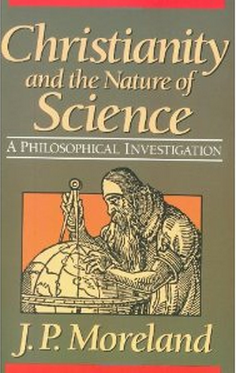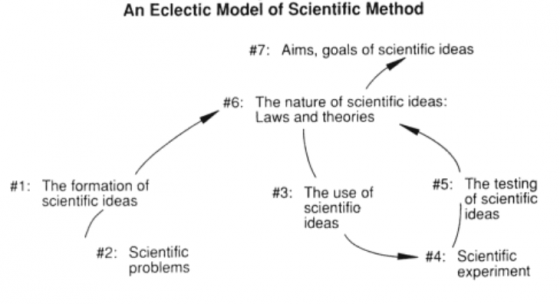 J. P. Moreland’s Christianity and the Nature of Science: A Philosophical Investigation (Grand Rapids, MI: Baker, 1989) is “an attempt to show that philosophy of science has much to contribute to the interface between science and theology” (248), with the goal “to help believers see that science and theology have interacted with each other and should” (13).
J. P. Moreland’s Christianity and the Nature of Science: A Philosophical Investigation (Grand Rapids, MI: Baker, 1989) is “an attempt to show that philosophy of science has much to contribute to the interface between science and theology” (248), with the goal “to help believers see that science and theology have interacted with each other and should” (13).
Moreland defends three theses:
1. There Is No One Definition of Science or Such a Thing as the Scientific Method that Excludes Philosophy or Theology
He writes:
First, there is no definition of science, no set of necessary and sufficient conditions for something to count as science, no such thing as the scientific method, that can be used to draw a line of demarcation between science and nonscience.
Nothing about science essentially excludes philosophical or theological concepts from entering into its very fabric.
Science is not an airtight compartment isolated from other fields of study, and there is nothing unscientific about creation science.
This may seem counter-intuitive. No sufficient and necessary conditions for something to count as science? No one scientific method? Moreland explains the former in chapter 1 and the latter in chapter 2.
Defining science is largely a philosophical, not scientific, endeavor—the proper domain of philosophers not scientists: “The question of defining or stating necessary and sufficient conditions for science is in large measure philosophical. . . . The view that scientists are uniquely qualified to define science is due in large measure to an education system that emphasizes pragmatic considerations, stresses analysis instead of synthesis, and deemphasizes the humanities.”
On scientific methodology, Moreland writes “the claim that there is a fairly clear thing called the scientific method that distinguishes science from other fields of study like theology . . . is naive because it fails to take seriously both the nature of human action in general and the various issues involved in analyzing scientific methodology” (my emphasis).
Moreland concludes:
- “. . . the question of whether there is something called the scientific method is itself a philosophical question (and a historical one), not primarily a scientific question. Science enters the point of providing examples of scientific practices to analyze. But the analysis of scientific methodology is properly the domain of historians and philosophers of science” (101).
- “. . . there is not single thing called the scientific method. Such a notion is a myth for at least three reasons: 1) There is a debate about the relative merits of inductivism and a more eclectic model of science. 2) There are different areas of debate within the eclectic model of science. 3) Different areas of science and different stages in the development of some particular areas of science use different aspects of the various areas we have discussed in analyzing the eclectic mode.” (101)
- “. . . it is more proper to say that there is a family of methodologies used by various areas of science, methodologies that are only capable of broad characterization. So understood, disciplines outside science like theology can be shown to use various aspects of scientific methodology. The idea that science is a rational, truth-seeking discipline and theology is not is a widespread cultural myth. This myth often is promulgated by contending that science gains its status by its privileged use of specific methodology not available to theology. But such a claim is itself a myth—the myth of ostrich scientism—that needs to be laid to rest.” (101)
2. There Are Limits to Science
He writes:
Limits to science arise in a number of interesting ways, and these limits are sufficient to do two things:
1) They show that scientism—the view that science alone is a rational approach to the world that secures truth—is false.
2) They weaken the epistemic authority of science, depriving it of its claim to dominate or overrule theology and philosophy. The interaction between science and theology or philosophy is a dialogue, not a monologue.
3. An Eclectic Model of Science Should Be Used to Integrate Science and Theology
Finally, Moreland argues:
Attempts to integrate science and theology, including efforts to resolve apparent conflicts between them, should not automatically assume a view of science known as scientific realism.
Scientific realism, roughly defined, is the view that successful scientific theories are true or approximately true models of the theory-independent world.
A number of antirealist approaches to science agree that science works—it solves problems, gives us predictions, allows us to control nature and describe observations simply—but that its success does not indicate that scientific theories are true or approximately true.
An eclectic model of science, one that uses a realist or antirealist view of science on a case-by-case basis, should be used to integrate science and theology. (13-14)

This is a very helpful book for thinking through the nature of science and the way in which philosophy and theology interact with it.
For more introductory books, see John A. Bloom’s new little book, The Natural Sciences: A Student’s Guide, and from an apologetics angle, John Lennox’s God’s Undertake: Has Science Buried God?
Finally, even though it won’t be out until February 2016, you should keep an eye out for the forthcoming book by Mitch Stokes, How to Be an Atheist: Why Many Skeptics Aren’t Skeptical Enough.


















